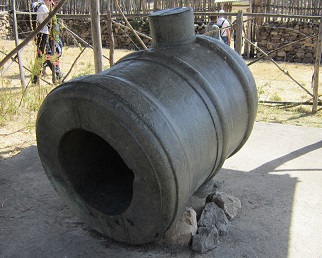


|
The British Expedition to Abyssinia was a rescue and punitive expedition carried out in 1868 against Emperor Tewodros II of Ethiopia, he had imprisoned several missionaries and two British officials in an attempt to get the help of the British government. His position as ruler had become precarious as much of Ethiopia was in revolt against him and he was engaged in constant military campaigns against a wide array of rebels.
Britain had refused his requests for military assistance. The punitive expedition launched by the British in response required the transportation of a sizable military force hundreds of miles across mountainous terrain lacking any road system. Therefore Sir Robert Napier, was given command of the expeditionary force. This was a very unusual decision as it was the first time a campaign had been entrusted to an officer from the Corps of Royal Engineers. On the right we see the 7 Tonne Mortar belonging to The Emporer Tewodros on site at Magdala Source: www.military-history.org |
| British | Ethiopian Empire | ||
|---|---|---|---|
 |
strength - 13,000 Casualities - 2 wounded 18 Regiments used: British Army 3rd (Prince of Wales's) Dragoon Guards 4th (The King's Own Royal) Regt of Foot 26th (The Cameronian) Regt of Foot 33rd (Duke of Wellington's) Regt of Foot 45th (Sherwood Foresters) Regt of Foot Indian Army 10th Regt of Bengal Lt Cavalry 12th Regt of Bengal Cavalry 3rd Regt of Bombay Lt Cavalry 21st Punjab Regt Bengal Native Infantry 23rd Punjab Regt Bengal Native Infantry (Pioneers) 2nd Bombay Native Infantry (Grenadier) 3rd Bombay Native Infantry 10th Bombay Native Infantry 21st Bombay Native Infantry (Marine) 25th Bombay Native Light Infantry 27th Bombay Native Infantry (1st Baluch) No 1 Company of Bombay Native Artillery Corps of Madras Sappers and Miners Corps of Bombay Sappers and Miners |
 |
strength - 4,000 Casualities - 700 dead, 1400 wounded |
|
Note Numbers are Approximate | |||
| Boldon Combatants | ||
|---|---|---|
| Private | Henry Knowles | A Colliery Worker employed at Boldon Pit for over 40 year |